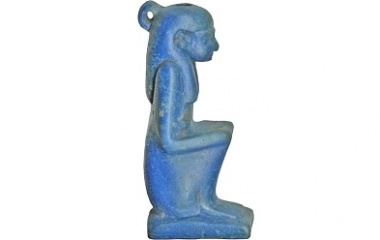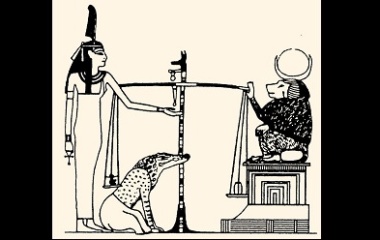- Pronunciation: mah-att
- Other names: Ma’at, Mayet
- Powers: Goddess of truth, justice and universal harmony
- Parents: Ra
- Children: The eight gods of Hermopolis
- Counterpart: Ra, Thoth or Seshat
Many cultures have recognized that our universe is in a constant struggle between the twin forces of chaos and order. Modern scientists tell us that the whole universe is on an unstoppable decline towards a state of total disorder known as “entropy”. The Vikings also believed that a chaotic end time known as the “Ragnarok” would inevitably take place.
The ancient Egyptians were no different in recognizing order and chaos, but their view was that great beings worked to keep these forces in balance. On the side of chaos was its personification, Isfet. Standing in opposition to Isfet and all the evil in the world, was the goddess Maat. Her difficult task was inextricably entwined with the duties of the pharaohs and the very fabric of Egyptian society.
Who Is Maat?
Maat is both a person and an idea. As an idea, she is the concept of truth and justice. She is a custodian of the laws and values of Egypt, as well as universal harmony.
Maat was also responsible for making sure that the rhythms and forces of the natural world kept running as they should, from the stars in the sky to the day-to-day lives of humans.
When someone died, Maat would stand in judgement of their souls. If their soul was not so burdened that it weighed more than her feather of truth, it could move on to the afterlife.
Appearance
Maat is depicted as a beautiful young woman. Usually, she is holding an Egyptian-style sceptre (or “was”) in one hand and an ankh in the other. These two objects have very strong symbolic meaning to Egyptians. The “was” is a symbol of power and the ankh is well-known as a symbol of eternal life.
In some pictures of her, she has wings under each arm and can also be shown with her ostrich feather of truth on her head. It’s against the weight of this feather that the souls of the dead would be judged in the afterlife.
In addition to this, another symbol that is associated with Maat is the scales. It seems that equating scales with balance, harmony and justice is a tradition that stretches far back into ancient times.
Family
Maat is usually described as being the daughter of Ra, the sun god. She has no mother and was created by Ra when he rose from the water of chaos, or “Nun,” as it is known in Egyptian. Sometimes, however, Maat is not credited as being Ra’s daughter, but his wife.
Although there is no complete agreement on it, many stories indicate that Maat was married to Thoth, the god of wisdom. In the latter periods of Egyptian mythology, male and female gods and goddesses were paired as complementary aspects of each other, and since Maat and Thoth shared many similar attributes, they were seen as a logical match.
Thoth is not always the mate of Maat, however. Some stories tell us that Thoth’s female counterpart is Seshat. Seshat is the goddess of writing, knowledge and measurement, which also makes her a logical match for Thoth. So far there is no solid evidence that shows which of these versions of the story is most accurate.
In the stories where she is paired with Thoth, Maat has a total of eight children with him. These eight children were the gods of the city Hermopolis. Thoth is the Egyptian equivalent of Hermes, hence the city name.
In the Hermopolis cult, it was these eight gods that were responsible for creating the world and everything in it.
Origin and History
The earliest mention of Maat in ancient Egyptian records occurs more than 2300 years ago.
Maat was one of the gods created when the sun god Ra emerged from the chaotic and primordial waters of Nun.
Maat was order, justice and harmony. At first, the entire universe was filled with Maat, but with the fall of mankind, disorder, evil and chaos entered the universe in the form of Isfet. There was a constant battle to defend Maat, a duty that fell on the pharaohs in particular, but resided with all people.
Maat spent her time helping the pharaohs maintain justice and order. She presided over the entrance to the afterlife and was protected by every Egyptian. If she were ever to be defeated, the universe would descend into complete chaos and disorder.
One of Maat’s most important tasks was to guide Ra’s path across the sky each day as the sun. She helped him plot the course to avoid danger, making sure he completed every journey safely.
Later Influence
The mythology of Maat had quite a bit of influence on the ancient world, and even today we can still see things that have been inspired by this goddess.
Isis is probably the goddess figure most closely related to the idea of Maat, and sometimes they could even be seen as one being. It’s possible, although still arguable, that Isis was also the inspiration for the Christian Mother Mary, which means that Maat may have had some influence on at least one of the major modern religions.
Where we see the influence of Maat most clearly in the modern world has to be the presence of Lady Justice. She can be seen as a statue in front of many courts: a blindfolded woman holding a sword and scales. There is little doubt that Maat’s image has strongly inspired this modern symbol of law and order.
So it may be accurate to say that, although no one calls this goddess of justice by her ancient name anymore, every day thousands of people who stand in judgement in the courts of the world hope that this lady of justice will be merciful to them.










